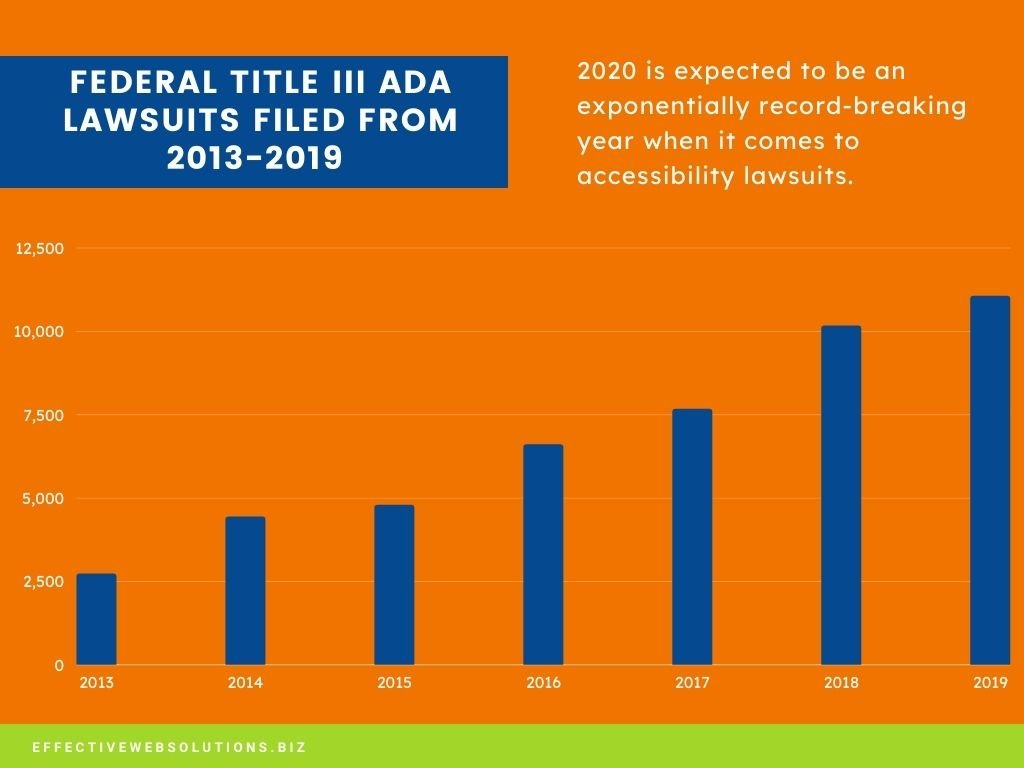ADA Compliant Websites: Who is Required to Have Them?
Having an ADA compliant website for your small business is important for a number of reasons. User experience (UX) is one of Google’s primary factors when determining search engine results. In order to have the best user experience possible, you need to make your website accessible to as many people as possible. Did you know that 20% of Americans have some form of disability? If your website isn’t ADA compliant or accessible, you lose out on all of those potential customers when they can’t get the information they need. Also, your business can get a tax credit of up to $5,000 per year for having a maintained, ADA-compliant website.
Am I Legally Required to Make My Website ADA Compliant?
Despite loads of misinformation out there, yes, you are required to make your website ADA compliant.
What is ADA Compliance?
The ADA (Americans with Disabilities Act) passed in 1990. The law prohibits discrimination against people with disabilities. The act covers all public sectors, including jobs, schools, transportation, and public places (or private places open to the public). The purpose of the ADA is to ensure that people with disabilities have the same rights and opportunities as able people.
In 2010, the United States Department of Justice passed the ADA Standards for Accessible Design. This process mandated that all electronic and information technology (such as websites) must be accessible to people with disabilities, including vision impairment and hearing loss.
Which Businesses Must Comply with the ADA?
Title I of the ADA claims that any business with at least 15 employees that operates for 20 or more weeks every year is covered by the law.
Title III of the ADA states that business that fall into the category of “public accommodation” must comply with ADA, including both digital and physical accommodations. Public accommodation businesses include hotels, banks, and public transportation (among others).
However, keep in mind that Title I of the ADA only really applies to physical accommodations. A website is considered “public accommodation,” so no matter how many employees you have, you must make your website ADA compliant.
What Happens If My Website Isn’t ADA Compliant?
If your small business’s website isn’t ADA compliant, you run the risk of a lawsuit. Over the last few years, plaintiffs in New York and California have brought a record number of accessibility lawsuits against businesses and 2020 is looking to be another record-breaking year with an estimated 100,000 cases being filed by December 31st. In June 2020, there were over 4,000 ADA lawsuits filed in California alone.
This trend of ADA accessibility lawsuits should be particularly worrisome for businesses in New York and California. The reason behind this is that both New York and California have corresponding civil rights acts at the state level that parallel the ADA when it comes to requiring non-discrimination. The difference between the ADA and these state civil rights acts is that the state laws provide plaintiffs the ability to capture damages beyond court and attorneys’ fees.
How Much Does an Accessibility Lawsuit Cost?
The average ADA lawsuit costs businesses between $10,000 and $50,000 (per incident). This amount of money can be crippling for small service-based businesses, such as the bulk of our clients here at Effective Web Solutions.
How to Avoid Website Accessibility Lawsuits

The easiest way to avoid a website accessibility lawsuit is to make your website accessible to people with disabilities. The problem with this is that there is no federal law that outlines specific requirements for websites. “As far as websites go, there is no federally codified direction on how to make websites comply,” said David Engelhardt, a New York City-based small business attorney. “We only know that the ADA does apply to websites based on cases such as Gil v. Winn-Dixie.”
What’s the best way to build an ADA-compliant website if there isn’t a clear definition of what that means? Based on litigation from the ADA compliance lawsuits mentioned above, the best practice is to follow web content accessibility guidelines (WCAG).
What are Web Accessibility Guidelines?
The web content accessibility guidelines (WCAG) are a set of guidelines provided by the World Wide Web Consortium (W3C). The guidelines are not law, but the guidelines have been cited in a court of law in accessibility lawsuits.
Who Needs Web Accessibility?
An accessible website provides equal access to a disabled person, regardless of their disability. A disabled person who needs a website to be up to accessibility standards may fall into any of the following categories:
People with Impaired Vision and Impaired Hearing
If your current website isn’t compatible with a screen reader, it is not accessible to blind people or blind and deaf people. People with impaired vision or people with both impaired vision and impaired hearing rely on screen readers for digital accessibility. A disabled person’s online experience is severely disrupted when websites don’t meet accessibility compliance guidelines.
Cognitive and Learning Difficulties
People with cognitive and learning difficulties, whether congenital or due to aging, may have trouble recalling large amounts of information or complicated information. A simple web page layout and the removal of animation and any other automated features are helpful for people with disabilities such as dyslexia and attention deficit hyperactivity disorder (ADHD).
Emotional and Behavioral Disabilities
To make a website more accessible for people with emotional and behavioral disabilities such as general anxiety disorder, it’s important to think critically about web page design. The user interface should have simple page layouts, sentence structure, and white space to help users with accessibility issues perceive information and stay on task.
Permanent or Temporary Injuries and Diseases
Many of us take it for granted that we can use a mouse, pointer, or touch screen to navigate the internet. However, many people suffer from disabilities that prevent them from using a mouse or any sort of touch screen interface. It’s important to make sure that your website is accessible by a screen reader and that all videos come with a text transcript to be accessible to as many people as possible. Also, ensuring that your website can be navigated with keyboard tab navigation is a way to ensure your company meets accessibility standards.
How Can Effective Web Solutions Help?
To improve your website accessibility, call us here at Effective Web Solutions. We are a full-service digital marketing agency. Along with targeting local customers for your business, we can ensure that your website is ADA compliant and accessible for people with disabilities. If you are looking for more information about ADA website compliance, call us today to set up an appointment and see what EWS can do for you to make your website perceivable to all of your customers.

